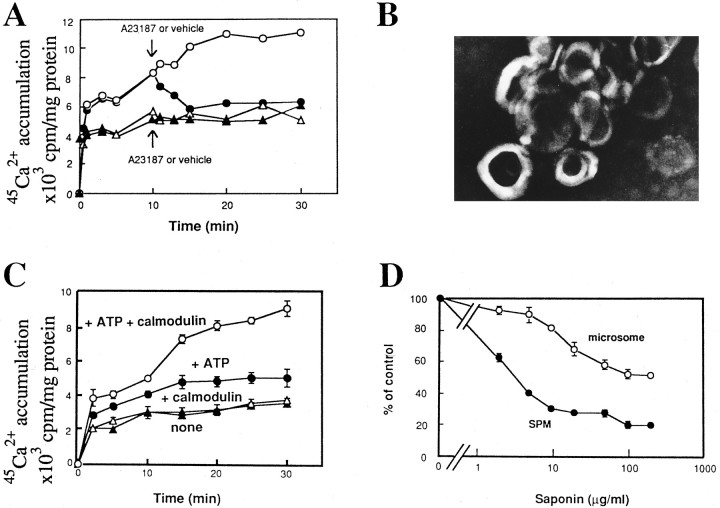Fig. 1.
Accumulation of45Ca2+ into resealed vesicles derived from SPM. A, Freshly prepared SPM (○, •) or previously resealed SPM vesicles (▵, ▴) was incubated with45Ca2+, and aliquot (100 μl) at each incubation time was used for determination of45Ca2+ incorporation, as described in Experimental Procedures. Results in the figure are representative profiles of the time course of45Ca2+ accumulation. Vehicle (○, ▵) or 5 μm A-23187 (•, ▴) was added to the assay tube at 10 min. B, An electron microscopic (negative-staining) image of the resealed SPM vesicles.C, Time course of ATP- and calmodulin-dependent45Ca2+ accumulation into previously resealed SPM vesicles, which was prepared in Experimental Procedures. Vehicle (▴), 5 μg/ml of calmodulin (▵), 1 mm ATP (•), or 5 μg/ml calmodulin plus 1 mm ATP (○) was added simultaneously with45Ca2+ to the tube containing previously resealed SPM vesicles. Experiments were performed under the condition of free [Ca2+] at 10 μm using 0.109 mmCaCl2 and 0.1 mm EGTA. Each point of data represents the mean ± SEM from three separate experiments. D, Blockade of45Ca2+ accumulation into resealed SPM vesicles and unlysed microsomes by pretreatment with various concentrations of saponin. In both experiments using resealed SPM vesicles and unlysed microsomes, incubation was carried out at 37°C for 30 min under the condition of free [Ca2+] at 100 nm in the presence or absence of 1 mm ATP. In resealed SPM vesicles, the ATP-dependent45Ca2+ incorporation in control (without saponin) resealed SPM vesicles (0.25 mg of protein/fraction) was 699 ± 20 cpm/fraction. Experiments using intact microsomes were performed as described in Experimental Procedures. The ATP-dependent 45Ca2+incorporation in control microsomes (0.25 mg of protein/fraction) was 209 ± 9.3 cpm/fraction. Data represent the mean ± SEM from three separate experiments.

